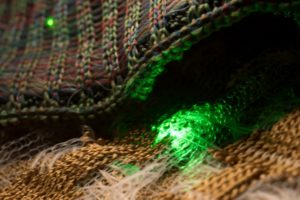
The latest development in textiles and fibers is a kind of soft hardware that you can wear: cloth that has electronic devices built right into it. MIT reports that a team of researchers has embedded high speed optoelectronic semiconductor devices, including light-emitting diodes (LEDs) and diode photodetectors, within fibers that were then woven into a soft, washable fabric and made into communications systems.
The findings are described in the journal Nature in a paper by former MIT graduate student Michael Rein; his research advisor Yoel Fink, MIT professor of materials science and electrical engineering and CEO of AFFOA (Advanced Functional Fabrics of America); and with a team from MIT and AFFOA; South Carolina-based Inman Mills; EPFL [École polytechnique fédérale de Lausanne] in Lausanne, Switzerland; and Lincoln Laboratory at MIT.
It has been a long-sought goal to create smart fabrics by incorporating semiconductor devices—the key ingredient of modern electronics and the missing piece for making fabrics with sophisticated functionality. The discovery, the researchers say, could unleash a new “Moore’s Law” for fibers, ie., a rapid progression in which the capabilities of fibers would grow rapidly and exponentially over time, just as the capabilities of microchips have grown over decades.
Optical fibers have been traditionally produced by making a preform, which is essentially a scaled-up model of the fiber, then heating it. The key breakthrough for producing the new fibers was to add to preform light-emitting semiconductor diodes the size of a grain of sand and a pair of copper wires a fraction of a hair’s width. When heated during the fiber-drawing process, the polymer preform partially liquified, forming a long fiber with the diodes lined up along its center and connected by the copper wires.
In this case, the solid components were two types of electrical diodes made using standard microchip technology: light-emitting diodes (LEDs) and photosensing diodes. “Both the devices and the wires maintain their dimensions while everything shrinks around them” in the drawing process, Rein says. The resulting fibers were then woven into fabrics, which were laundered 10 times to demonstrate their practicality as possible material for clothing. Inman Mills developed techniques that make it possible to weave the semiconductor fibers using a conventional, industrial, manufacturing-scale loom.
According to Rein, “Instead of drawing the material all together in a liquid state, we mixed in devices in particulate form, together with thin metal wires.” One of the advantages of incorporating function into the fiber material itself is that the resulting fiber is inherently waterproof.
“It is already allowing us to expand the fundamental capabilities of fabrics to encompass communications, lighting, physiological monitoring and more, says Fink. “In the years ahead, fabrics will deliver value-added services and will no longer just be selected for aesthetics and comfort.”
He says that the first commercial products incorporating this technology will be reaching the marketplace as early as next year. Such rapid lab-to-market development was a key part of the reason for creating an academic-industry-government collaborative such as AFFOA in the first place, he says. These initial applications will be specialized products involving communications and safety, but according to the researchers, the fibers could potentially have significant applications in the biomedical field, as well.
“It’s going to be the first fabric communication system. We are right now in the process of transitioning the technology to domestic manufacturers and industry at an unprecedented speed and scale,” Fink says.
The research was supported in part by the MIT Materials Research Science and Engineering Center (MRSEC) through the MRSEC Program of the National Science Foundation, by the U.S. Army Research Laboratory and the U.S. Army Research Office through the Institute for Soldier Nanotechnologies. This work was also supported by the Assistant Secretary of Defense for Research and Engineering.
 TEXTILES.ORG
TEXTILES.ORG


